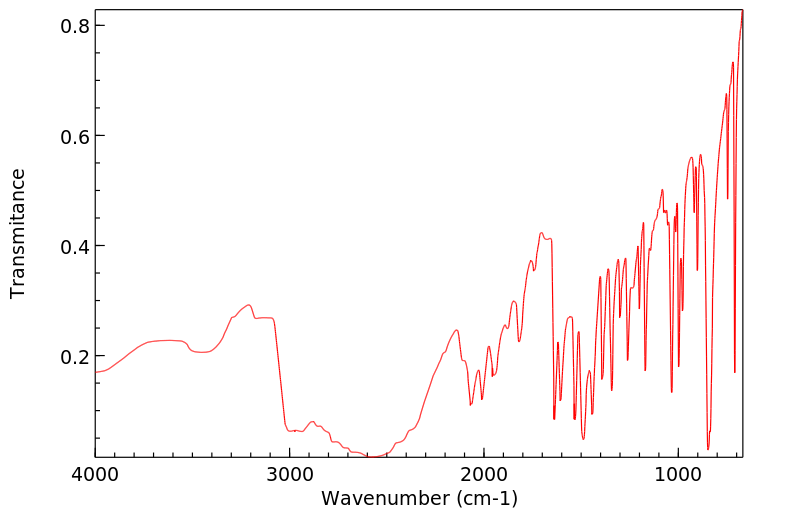3,4-二甲基吡啶盐酸盐 | 36316-69-5
中文名称
3,4-二甲基吡啶盐酸盐
中文别名
——
英文名称
3,4-dimethylpyridinium chloride
英文别名
3,4-lutidinium chloride;3,4-dimethylpyridine;hydron;chloride
CAS
36316-69-5
化学式
C7H10N*Cl
mdl
——
分子量
143.616
InChiKey
AMTHDYLSECUIBZ-UHFFFAOYSA-N
BEILSTEIN
——
EINECS
——
-
物化性质
-
计算性质
-
ADMET
-
安全信息
-
SDS
-
制备方法与用途
-
上下游信息
-
文献信息
-
表征谱图
-
同类化合物
-
相关功能分类
-
相关结构分类
计算性质
-
辛醇/水分配系数(LogP):2.12
-
重原子数:9
-
可旋转键数:0
-
环数:1.0
-
sp3杂化的碳原子比例:0.29
-
拓扑面积:12.9
-
氢给体数:1
-
氢受体数:1
SDS
反应信息
-
作为反应物:描述:potassium platinum(IV) thiocyanate*2H2O 、 3,4-二甲基吡啶盐酸盐 以 水 为溶剂, 生成 2(CH3)2C5H3NH(1+)*Pt(4+)*6SCN(1-)=((CH3)2C5H3NH)2{Pt(SCN)6}参考文献:名称:一些六硫氰酸根合铂酸盐的热分解摘要:摘要 获得了六种H 2 [Pt(SCN) 6 ]二元酸与金属和有机胺的盐,并通过化学分析对其进行了表征。这些化合物的热分解通过衍生学进行了研究。计算并讨论了该过程的一些动力学参数。将结果与之前使用类似的氯代和溴代衍生物获得的结果进行比较。DOI:10.1016/0040-6031(92)85204-9
-
作为产物:描述:3,4-二甲基吡啶 、 乙烯磺酰氯 在 potassium chloride 、 水 作用下, 以 乙二醇二甲醚 为溶剂, 生成 2-(3,4-dimethylpyridin-1-ium-1-yl)ethanesulfonate 、 3,4-二甲基吡啶盐酸盐 、 3,4-dimethylpyridine;ethenesulfonic acid参考文献:名称:乙烯基亲核催化。叔胺促进1-烯烃-1-磺酰氯的水解摘要:我们提供的证据表明,在吡啶、三甲胺和许多其他叔胺存在下,乙烯磺酰氯 (1) 和反式-1-丙烯-1-磺酰氯 (3) 与水的反应主要通过初始乙烯基取代反应形成阳离子亚砜,随后通过加成(和去质子化)与水反应形成甜菜碱,或通过乙烯基取代(和去质子化)得到烯烃磺酸根阴离子(R = H 或 CH3)。后者的形成代表了乙烯基亲核催化的第一个得到充分支持的例子。这些结论是从动力学和产品组成观察中得出的,包括 (a) 甜菜碱中的 α-单氘化和 D2O 中反应的乙烯磺酸缺乏氘化,DOI:10.1139/v84-339
文献信息
-
[CuCl<sub>3</sub>(H<sub>2</sub>O)]<sup>−</sup>complexes aggregated to form hydrate columns in methyl-substituted pyridinium or piperidinium salts作者:Sowjanya Nalla、Marcus R. BondDOI:10.1107/s0108270111017306日期:2011.6.151,2,3-Trimethylpyridinium aquatrichloridocuprate(II), (C8H12N)[CuCl3(H2O)], (I), 3,4-dimethylpyridinium aquatrichloridocuprate(II), (C7H10N)[CuCl3(H2O)], (II), and 2,3-dimethylpyridinium aquatrichloridocuprate(II), (C7H10N)[CuCl3(H2O)], (III), exhibit the same fundamental structure, with (I) and (II) isomorphous and with the unit-cell constants of (III) similar to the reduced unit-cell constants of (I) and (II). The distorted square-planar [CuCl3(H2O)](-) complex [mirror symmetric in (I) and (II)] forms two semicoordinate Cu center dot center dot center dot Cl bonds to a neighboring complex to produce a dimer with 2/m symmetry [only inversion symmetry in (III)]. The semicoordinate Cu center dot center dot center dot Cl bond length of the dimer shows significant elongation at 295 K compared with that at 100 K, while the coordinate Cu-Cl bond lengths are slightly contracted at 295 K compared with those at 100 K. The inorganic dimers are linked by eight hydrogen bonds to four neighboring dimers to establish a checkerboard network layer in the ab plane, with voids between the dimers that accommodate, on both sides, inversion-related organic cation pairs. The organic cations are required by mirror-plane symmetry to be disordered in (I) and (II). The organic cations and [CuCl3(H2O)](-) complexes are nearly coplanar and tilted out of the layer plane to establish a hybrid organic-inorganic layer structure parallel to (202) [(11 (2) over bar) in (III)], with hydrate columns (defined by water molecules) and hydrophobic columns (defined by methyl groups) parallel to each other [and along the 2(1) axes in (I) and (II)]. In 1,1-dimethylpiperidinium aquatrichloridocuprate(II), (C7H16N)[CuCl3(H2O)], (IV), the bulkier organic cation prevents semicoordinate bonding between complexes, which are hydrogen bonded side-to-side in zigzag chains that place water molecules in columns along half of the 2(1) axes.
表征谱图
-
氢谱1HNMR
-
质谱MS
-
碳谱13CNMR
-
红外IR
-
拉曼Raman
-
峰位数据
-
峰位匹配
-
表征信息
同类化合物
(S)-氨氯地平-d4
(R,S)-可替宁N-氧化物-甲基-d3
(R)-(+)-2,2'',6,6''-四甲氧基-4,4''-双(二苯基膦基)-3,3''-联吡啶(1,5-环辛二烯)铑(I)四氟硼酸盐
(R)-N'-亚硝基尼古丁
(R)-DRF053二盐酸盐
(5E)-5-[(2,5-二甲基-1-吡啶-3-基-吡咯-3-基)亚甲基]-2-亚磺酰基-1,3-噻唑烷-4-酮
(5-溴-3-吡啶基)[4-(1-吡咯烷基)-1-哌啶基]甲酮
(5-氨基-6-氰基-7-甲基[1,2]噻唑并[4,5-b]吡啶-3-甲酰胺)
(2S,2'S)-(-)-[N,N'-双(2-吡啶基甲基]-2,2'-联吡咯烷双(乙腈)铁(II)六氟锑酸盐
(2S)-2-[[[9-丙-2-基-6-[(4-吡啶-2-基苯基)甲基氨基]嘌呤-2-基]氨基]丁-1-醇
(2R,2''R)-(+)-[N,N''-双(2-吡啶基甲基)]-2,2''-联吡咯烷四盐酸盐
(1'R,2'S)-尼古丁1,1'-Di-N-氧化物
黄色素-37
麦斯明-D4
麦司明
麝香吡啶
鲁非罗尼
鲁卡他胺
高氯酸N-甲基甲基吡啶正离子
高氯酸,吡啶
高奎宁酸
马来酸溴苯那敏
马来酸氯苯那敏-D6
马来酸左氨氯地平
顺式-双(异硫氰基)(2,2'-联吡啶基-4,4'-二羧基)(4,4'-二-壬基-2'-联吡啶基)钌(II)
顺式-二氯二(4-氯吡啶)铂
顺式-二(2,2'-联吡啶)二氯铬氯化物
顺式-1-(4-甲氧基苄基)-3-羟基-5-(3-吡啶)-2-吡咯烷酮
顺-双(2,2-二吡啶)二氯化钌(II) 水合物
顺-双(2,2'-二吡啶基)二氯化钌(II)二水合物
顺-二氯二(吡啶)铂(II)
顺-二(2,2'-联吡啶)二氯化钌(II)二水合物
韦德伊斯试剂
非那吡啶
非洛地平杂质C
非洛地平
非戈替尼
非布索坦杂质66
非尼拉朵
非尼拉敏
雷索替丁
阿雷地平
阿瑞洛莫
阿扎那韦中间体
阿培利司N-6
阿伐曲波帕杂质40
间硝苯地平
间-硝苯地平
镉,二碘四(4-甲基吡啶)-
锌,二溴二[4-吡啶羧硫代酸(2-吡啶基亚甲基)酰肼]-







